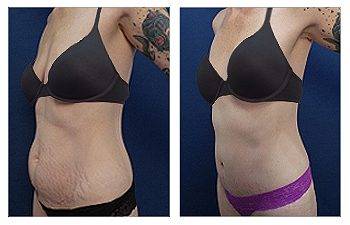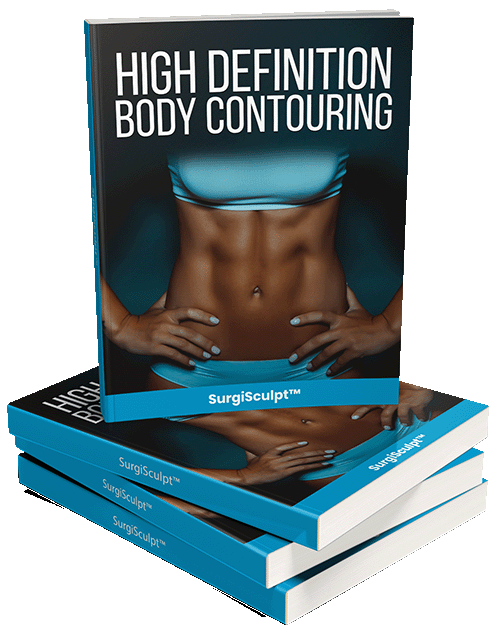


Introduction: Eliminating lower belly stretchmarks with tummy tuck
A tummy tuck, called an abdominoplasty, will not only provide you with the elimination of the excess skin and fat from your stomach but also eliminate lower belly stretch marks. Eliminating lower belly stretch marks with a tummy tuck is one of the many benefits of a tummy tuck. How far your stretch marks extend skin redundancy, and the position of your belly button will determine your capacity for eliminating lower belly stretch marks with a tummy tuck.
These considerations also determine whether you should undergo a mini tummy tuck or a full tummy tuck. The location of the belly button and the degree of skin redundancy will also affect where your final incision line will lie.
The belly button position cannot be any closer than 10 cm to the top of the pubic triangle, where your final incision is. Your surgeon sets that incision depending on where it will be more aesthetically pleasing for your body in eliminating lower belly stretch marks. That line is typically where your groin crease ends. For proportions and aesthetic beauty, the incision should not be any closer than 7 cm to the top of your vaginal apex.
If stretch marks are located below the 8-10 cm mark, extending down to the pubic line, you can get away with a mini tummy tuck. If the stretch marks get any closer to the belly button, a full tummy tuck is indicated.
Additionally, if your muscles have stretched out, you must perform the full tummy tuck because the mini tummy tuck does not give your surgeon full access to repair the abdominal muscles. Now that you have a layout of the differences between a mini tuck and a full tummy tuck, let us get into the details of stretch marks and tummy tuck surgery.
Stretch marks, often referred to in medical terms as striae, are scars that develop due to the rapid stretching of the skin. This sudden stretching can be caused by numerous factors – rapid weight gain or loss, growth spurts during adolescence, and most commonly, pregnancy. These silver or purple jagged marks can have profound effects on one’s self-esteem, leading many to search for effective remedies. Among the myriad of solutions available, tummy tucks have emerged as a beacon of hope for many.
Tummy Tuck: Beyond the Basics
The Evolution of Abdominoplasty
A tummy tuck, known more formally as abdominoplasty, is not a newfound procedure. Originating in the early 20th century, the procedure has undergone numerous advancements, refining the process and enhancing results. This surgical intervention aims to remove excess skin and fat, often from the abdominal region, providing a tighter, more toned appearance.
The Procedure’s Effect on Stretch Marks
Abdominoplasty is unique in addressing stretch marks. As the skin bearing these marks is often removed during the surgery, the stretch marks effectively get excised. The result? A smoother skin texture free from the unsightly streaks that once marred it.
Delving Deeper: The Multifaceted Benefits of a Tummy Tuck
Beyond the Aesthetic Appeal
The primary allure of a tummy tuck might be its ability to sculpt the abdomen, but its benefits are manifold. It’s a procedure that offers therapeutic advantages. For instance, many women post-pregnancy experience diastasis recti – a condition where the abdominal muscles separate. A tummy tuck can correct this, restoring the muscles to their original position.
A Catalyst for Confidence
The psychological benefits of a tummy tuck are immense. From wearing figure-hugging dresses to feeling comfortable at the beach, the surge in self-confidence post-surgery can be life-changing for many. A body free from sagging skin and stretch marks often translates to a mind free from insecurities.
Holistic Health Benefits
Posture is an oft-overlooked aspect of our health. With weakened abdominal muscles, conditions like lordosis or “sway back” can develop. A tummy tuck rectifies this by tightening the abdominal muscles, aiding in better posture. This can, in turn, alleviate associated back pain, providing patients with a dual advantage.
Contemplating a Tummy Tuck: A Thoughtful Decision
Setting Realistic Expectations
It’s paramount for prospective patients to harbor realistic expectations. While a tummy tuck can work wonders, it’s not a panacea. It won’t aid significant weight loss and won’t guarantee the complete elimination of stretch marks if they’re located outside the excised skin area.
A Deep Dive into the Risks
All surgical interventions carry risks. With tummy tucks, there’s the potential for infections, undesirable scarring, complications linked to anesthesia, and prolonged healing. Additionally, there are nuances like numbness or a change in skin sensation and the possibility of revision surgery. Hence, choosing a qualified, board-certified surgeon becomes paramount.
The Financial Implications
Abdominoplasty is an investment – both in terms of time and money. Costs can vary depending on geographic location, the surgeon’s expertise, and the intricacy of the procedure. It’s also worth noting that many insurance plans do not cover tummy tucks unless they’re deemed medically necessary, so financial planning is crucial.
Post-Procedure: The Journey to Recovery
The First Few Days: What to Expect
The immediate days post-surgery can be challenging. Patients might experience pain, swelling, and bruising. Discomfort is natural, and doctors usually prescribe medications to alleviate these symptoms. Drains might be placed to prevent fluid buildup, and patients will typically be instructed to wear a compression garment to support the healing tissues.
The Long Road to Complete Recovery
While the initial recovery might span weeks, complete healing can take months. It’s essential for patients to be patient and kind to themselves during this time. Regular check-ups with the surgeon, following their guidelines, and keeping an eye out for signs of complications like increased redness, swelling, or discharge are essential.
Nurturing Your New Contour
A successful tummy tuck is a collaborative effort between the surgeon and the patient. Post-surgery, maintaining a stable weight is crucial. Significant weight fluctuations can compromise the results. A balanced diet and regular exercise become key components in preserving the surgery’s outcomes.
Potential Scarring and Its Management
Scarring is a natural aftermath of any surgery. With tummy tucks, the scars usually run horizontally between the hip bones. Over time, with proper care, these scars fade, but they don’t disappear entirely. Emollients, silicone gel sheets, and certain treatments can help in reducing their appearance.
Concluding: Eliminating lower bell stretch marks with tummy tuck
Opting for a tummy tuck is a deeply personal decision, influenced by numerous factors ranging from physical discomfort to aesthetic desires. While it’s a procedure brimming with potential, it’s not devoid of risks. Proper research, setting the right expectations, and choosing a competent surgeon can pave the way for a successful surgery and a happier, more confident you.
For further insights on abdominoplasty, its evolution, and the latest advancements, the American Society of Plastic Surgeons is an invaluable resource.
Please see this 36-year-old female 3 months following tummy tuck surgery eliminating lower belly stretch marks and bilateral breast lift.

